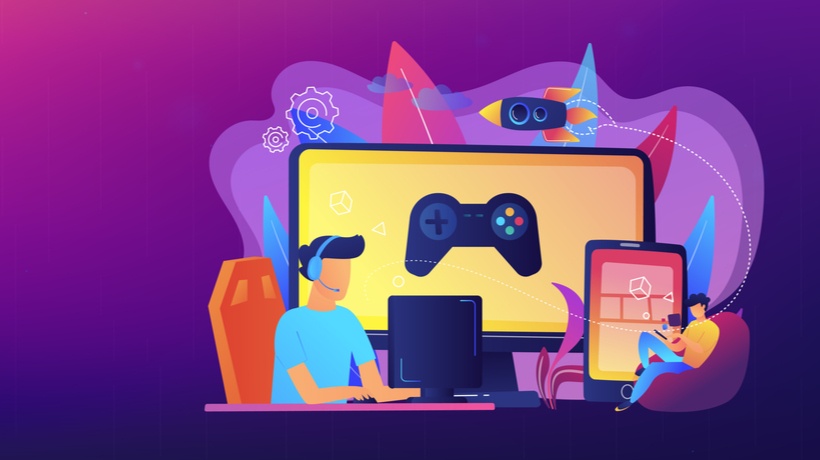Gamification in education can provide numerous benefits, including increased engagement and motivation for learners. It is a strategy that involves using game elements in a non-game setting, such as a classroom, to enhance the learning experience.
By making learning fun and interactive, gamification can help students retain information better and develop critical thinking skills. Additionally, it can provide teachers with real-time data on student progress and allow for personalized learning experiences. In this article, we will explore the benefits of gamification in education and how it can be implemented effectively to improve student outcomes.

Credit: elearningindustry.com
Understanding The Benefits Of Gamification In Education
Gamification has transformed the traditional education system, facilitating innovative learning approaches that encourage active participation from students. Through the application of game mechanics, students can now learn difficult concepts and topics in an exciting and engaging manner. Under the subheading ‘understanding the benefits of gamification in education,’ we will explore the impact of gamification on education, highlighting four key benefits.
Improved Engagement And Attention
Enhanced engagement is a critical advantage of gamification in education that cannot be overlooked. By applying game design elements in learning, students become more attentive and invested in their studies. This increased level of engagement is achieved through the satisfaction obtained from completing game stages.
Additionally, games’ competitive nature fosters better participation and collaboration among peers, consequently creating a more enjoyable environment for learning.
Some of the ways gamification enhances engagement and attention include:
- The intriguing storyline prompts students to stay interested and follow the lesson to the end.
- The immersive and interactive gameplay helps learners to focus, thus increasing their comprehension and memory retention.
Enhanced Motivation To Learn
Motivating students to learn can be challenging, especially for subjects they consider dull or challenging. Gamification can provide the necessary stimulus to keep students keen on learning, irrespective of their interested subjects.
Gamification creates an achievable goal, and the challenges embedded in the games’ design make it easier to understand and absorb new concepts. By giving learners a sense of control over their learning, gamification boosts their intrinsic motivation towards achieving educational goals.
Here are some ways in which gamification enhances motivation to learn:
- The natural awe and curiosity that come with games create motivation to explore and experiment, which can lead to better performance in class.
- The reward system built into games incentivizes learners to complete tasks and boosts their motivation to progress.
Better Retention Of Information And Knowledge
Gamification’s key advantages in education is their ability to facilitate better knowledge and information retention. Due to the practical and interactive nature of learning through gamification, students are more likely to remember and understand information studied than through traditional lectures or textbooks.
Moreover, studies have shown that students who learn through gamification have a higher retention rate, especially on complex topics and subjects.
Here are some ways gamification enhances retention of information and knowledge:
- The adaptive nature of gamification through tracking individual progress and providing feedback helps learners remember and recognize their progress.
- Gamification’s use of various forms of multimedia, such as graphics, audio, and video content, can positively improve learners’ memory retention.
Alleviation Of Stress And Anxiety Related To Learning
Gamification provides a safe and nurturing environment for learners to develop and experiment without fear of failure, criticism, or punishment. This kind of environment helps to reduce the anxiety and stress associated with learning.
Here are a few ways gamification can help alleviate stress and anxiety related to learning:
- Gamification techniques, such as game-based assessment, encourage creative thinking and problem-solving skills, which distracts learners from stress and anxiety.
- Game-like elements can make difficult or mundane tasks feel more approachable, which helps learners feel less fearful and anxious about engaging with the learning material.
Gamification significantly enhances the traditional education system, providing an alternative way of learning that is more enjoyable and efficient. The benefits are enormous, including improved engagement, motivation to learn, better knowledge and information retention, and the alleviation of stress and anxiety related to learning.
Therefore, incorporating gamification into the education system is paramount for a better learning experience and knowledge acquisition.
Unlock The Secrets: How Gamification Enhances Learning
Gamification is transforming education by adding gaming elements that make learning more interactive and engaging. By incorporating game mechanics such as points, badges, and leaderboards, educators are unlocking the secrets of how gamification enhances learning. Let’s explore some of the benefits of gamification in education and see how teachers can use it to help students better understand complex concepts.
Incorporating Gaming Elements Into Education
- Add excitement and motivation to learning by incorporating gaming elements such as points, badges, and leaderboards.
- Allow students to track their progress and compete against each other.
- Promote collaboration and teamwork by adding elements such as group challenges and quests.
- Provide immediate feedback to students, which can help them identify their strengths and weaknesses.
Role-Playing Games For Language And Social Studies
- Use role-playing games to help students learn languages by immersing them in real-life situations.
- Develop critical thinking and decision-making skills through scenarios that present moral dilemmas or cultural differences.
- Improve students’ understanding of social studies by simulating historical events and allowing them to interact with historical figures.
- Encourage creativity and imagination by allowing students to create their own characters and stories.
Interactive Quizzes And Assessment Tools
- Make learning more interactive by using quizzes and assessment tools that offer immediate feedback.
- Use gamification to motivate students to complete assessments and improve their scores.
- Help students identify their strengths and weaknesses by providing detailed feedback on their answers.
- Create personalized learning experiences by adapting quizzes to individual students’ needs.
Simulation And Virtual Reality Games For Experiential Learning
- Allow students to experience real-life situations through simulation and virtual reality games.
- Improve students’ problem-solving skills by challenging them with complex scenarios.
- Help students understand abstract concepts by allowing them to interact with them in a simulated environment.
- Create realistic environments that can be used to teach skills such as engineering, medicine or business.
Gamification is revolutionizing education by making learning interactive and engaging. By incorporating gaming elements, teachers can promote collaboration, healthy competition, and provide immediate feedback. Gamification helps educators create personalized and immersive learning experiences that improve students’ understanding of complex concepts.
Examples Of Gamification In Education
Gamification is the process of incorporating gaming elements into non-game contexts such as education, to motivate and engage learners. The use of gamification has become increasingly popular in the education sector due to its ability to enhance the learning experience.
We will explore examples of gamification in education and how it has helped to level up the learning experience for students.
Kahoot And Quizlet As Examples Of Interactive Quizzes And Assessment Tools
Interactive quizzes and assessment tools, when correctly gamified, can increase student engagement, motivation, and learning outcomes. Two popular examples of such tools are kahoot and quizlet.
Kahoot is an interactive quiz tool with a user-friendly interface that allows educators to create engaging quizzes and games, gamifying the learning process and keeping students engaged. The tool is user-friendly and straightforward, allowing educators to create, host, and share quizzes with ease.
With kahoot, students can participate in quizzes and games in real-time, enhancing their learning experience.
Quizlet is another popular assessment tool used by educators worldwide that engages learners through game-like experiences. Quizlet allows educators to create flashcards, quizzes, and study sets, thereby gamifying the learning process, making it more engaging and enhancing students’ learning experiences.
Minecraft And Simcity As Examples Of Simulation And Virtual Reality Games For Experiential Learning
Simulation and virtual reality games are unique ways to create experiential learning that has proven to be highly effective. Minecraft and simcity are two games that have been effectively integrated into the education sector.
Minecraft, a sandbox video game, provides a creative and immersive environment that can be used to develop creativity and critical thinking in class. Educators use minecraft to create learning experiences that engage students in the process of designing, building, and problem-solving.
Simcity, on the other hand, is a city-building simulation game that provides students with the opportunity to explore the dynamics of city planning, politics, and management. Simcity has been effectively used to teach key concepts in social studies, geography, and economics.
Duolingo As An Example Of A Language Learning App That Incorporates Gaming Elements
Duolingo is an app that provides an interactive and gamified way of learning a new language. It has become a popular tool for language learners worldwide, incorporating several gaming elements to make the learning process engaging and enjoyable.
Duolingo uses a variety of gaming elements such as rewards and achievements, gamifying the learning process and keeping learners engaged. Moreover, duolingo’s user-friendly interface and engaging content make it an enjoyable and effective tool for learning new languages.
Gamification has transformed the traditional learning experience through the use of engaging and interactive gaming elements that increase student engagement, motivation, and learning outcomes. Interactive quizzes, simulation and virtual reality games, and language learning apps are examples of gamification in education that have proven to be highly effective.
Educators who choose to integrate gamification into their teaching approach can undoubtedly level up the learning experience for their students.
Overcoming Challenges In Implementing Gamification In Education
Leveling Up Education: Exploring The Benefits Of Gamification
Gamification is revolutionizing the education system, giving teachers and students a new way of teaching and learning. With its fun and interactive approach, it is no surprise that gamification in education is increasingly becoming more popular. However, implementing gamification in education is not without challenges.
Resistance From Educators And Students
Resistance from educators and students is one of the significant challenges in implementing gamification in education. Some educators are hesitant about incorporating gamification in their teaching practices. They argue that it could lead to distractions and make students lose focus.
Similarly, some students may resist gamification because they are not used to this approach in learning. Nevertheless, these challenges can be overcome by providing adequate training for educators and introducing gamification in small doses to students until they get accustomed to it.
Over-Reliance On Technology
Over-reliance on technology is another challenge faced by educators who would like to introduce gamification in education. Many educational institutions don’t have access to adequate technology, which could make it challenging to implement gamification. Moreover, technology can fail, leading to a lack of motivation and interest in students.
Therefore, it is crucial to strike a balance between technology and traditional teaching methods while implementing gamification.
Balancing Game Elements With Traditional Methods Of Teaching
Gamification should not replace traditional teaching methods. Educators must balance game elements and traditional teaching methods when incorporating gamification into their curriculum. A balance must be found to ensure that the students are learning and achieving their academic goals while still having fun and being engaged.
- Games should be relevant to the topic being taught.
- Games should be used as an educational tool to supplement traditional teaching methods.
- Educators should observe if gamification improves student participation and learning.
Ensuring Equal Access To Technology For All Students
Gamification requires the use of technology, which could be a problem for students who don’t have equal access to technology. It is essential to ensure that all students have equal opportunities, regardless of their socio-economic status. It may be necessary to provide equal access to technology or make use of non-tech alternatives to incorporate gamification in education.
- Provide equal opportunities for all students.
- Find funding sources to support the integration of technology in schools.
- Use non-tech alternatives for students who don’t have access to technology.
Gamification in education has proven to be an effective method of teaching and learning. However, educators must be aware of the challenges they may face while implementing gamification and take appropriate measures to overcome them. With careful planning and execution, gamification in education can help students have fun while achieving their academic goals.
Best Practices For Successful Implementation Of Gamification In Education
Collaboration Between Educators And Game Developers
Gamification in education requires collaboration between educators and game developers to create effective and engaging learning experiences. The following points highlight the best practices for successful implementation of gamification in education through collaboration:
- Educators should provide game developers with relevant educational materials to incorporate the learning objectives into the game.
- Game developers should involve educators in the game development process to ensure that the games are pedagogical and meet the requirements of the curricula.
- Both educators and game developers should discuss the features that motivate students and promote learning, such as rewards, feedback, and social interactions.
Focusing On Learning Outcomes Rather Than Just Gameplay
Gamification should not only be about playing games but also achieving learning outcomes. The following points highlight the best practices for successful implementation of gamification in education by focusing on learning outcomes:
- The focus should be on learning, not just playing. It is crucial to align the learning objectives and outcomes with the game mechanics.
- The game elements should enhance the learning process by providing students with immediate feedback, progressive goals, and challenges that promote critical thinking and problem-solving skills.
- The learning outcomes should be measurable and evaluated based on the students’ progress and achievements.
Balancing Competition With Cooperation
Gamification in education often involves both competition and cooperation among students. It is essential to balance these elements to ensure that students are motivated and engaged in their learning. The following points highlight the best practices for successful implementation of gamification in education by balancing competition and cooperation:
- Competition can motivate students to perform better, but it should not discourage them from learning. Games should promote healthy competition that encourages students to learn from their mistakes and support each other.
- Cooperation can foster a sense of community among students, but it should not undermine the learning outcomes. Games should promote collaboration, teamwork, and knowledge sharing that enhance the learning experience.
- The game mechanics should allow for adaptation and modification to meet the diverse needs and preferences of students.
Providing Differentiated Learning Opportunities For Students With Various Learning Styles And Abilities
Gamification in education should provide diverse learning opportunities that meet the needs of students with various learning styles and abilities. The following points highlight the best practices for successful implementation of gamification in education by providing differentiated learning opportunities:
- Games should cater to the diverse learning styles of students, including visual, auditory, and kinesthetic learners.
- Games should provide differentiated learning opportunities for students with different abilities. This can be achieved by adjusting the game mechanics, challenges, and feedback to meet the individual needs of students.
- Teachers should monitor and evaluate the progress of students to ensure that they are challenged and supported in their learning. Teachers should also provide feedback and guidance to enhance the learning experience.
Frequently Asked Questions For Leveling Up Education: Exploring The Benefits Of Gamification
How Can Gamification Improve Education?
Gamification can make learning more engaging, increase student motivation, and improve knowledge retention.
Is Gamification Effective In All Subjects?
Gamification is effective in most subjects, but is particularly effective in stem fields and language learning.
At What Age Can Gamification Be Introduced?
Gamification can be introduced at any age, but is most effective in children aged 5-18.
Conclusion
As we can see, gamification has the potential to revolutionize the education system. By applying game-like elements to the learning process, students can be engaged and motivated to achieve their academic goals. Not only that, but gamification also facilitates the development of various skills such as problem-solving, critical thinking, and teamwork.
Teachers can also benefit from gamification, as it allows them to provide feedback and track progress more efficiently. Additionally, the use of technology can enhance the learning experience and provide students with a more interactive and personalized approach to education.
That said, it is crucial to remember that gamification cannot and should not replace traditional educational methods. Rather, it should be used as a complementary tool to enhance the learning experience. With proper implementation and careful consideration, gamification can help level up education and pave the way for a brighter future.

